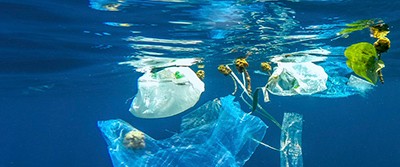Marine Microbes Could Help Fight Plastic Pollution

By Kylie Wolfe
In 2015, we produced 262.4 million tons of garbage in the United States alone. Some we recycled. Some found its way into the landfill, and the rest went into our oceans.
While life on land may seem unaffected, aquatic species aren’t as lucky. The unfortunately infamous Great Pacific Garbage Patch is growing, and an estimated 1,200 sea creatures are either eating plastic or living in it, even getting tangled and trapped. Sunlight and ocean currents manage to break down large pieces of plastic, but most of it isn’t fully biodegradable.
Searching for Answers
Researchers at the Technical University of Crete in Chania, Greece, recently discovered that there are microbes at sea helping to fight society’s trash problem. These tiny organisms are targeting plastic, a material that makes up 70% of all ocean litter.
Setting out to find answers, Evdokia Syranidou and his team visited two beaches near the university and collected two types of plastic: polyethylene and polystyrene. The former is used to make grocery bags and the latter is used in food packaging. All of the samples they collected had become brittle due to sun exposure and chemical changes, making it possible for marine microbes to take the next step.
These ocean organisms feed on plastic, using it as a source of carbon which helps to speed up the degradation process. They secrete enzymes to increase the rate of chemical reactions that break down the plastic’s polymer chains, impacting its structural integrity.
To mimic this process in an oceanic environment, they immersed each type of plastic they collected in two variations of saltwater, one containing naturally-occurring microbes and the other containing engineered microbes. They recorded their findings over five months and noticed a decrease in weight in plastic exposed to the naturally-occurring microbes: polyethylene by 7% and polystyrene by 11%. Their findings were accepted by the Journal of Hazardous Materials in April.
The team wrote that while the bioengineered strain wasn’t as successful at consuming the plastic, it was better at adhering to it and developing a biofilm. Ultimately, the most effective strategy was to use microbes previously exposed to plastic. It appears that this exposure allows them to develop a stronger desire to eat it, only becoming more efficient over time.
Planning for the Future
As society searches for ways to improve its approach to ocean pollution, marine microbes may play a small part in solving a larger issue. Researchers will need to determine how effective the assistance of these garbage guzzlers would be worldwide and if releasing more into our oceans would help solve our plastic pollution problem.
In the meantime, there are ways that society can pitch in. Simply recycling, buying fewer plastic-packaged products, and using reusable items can make a difference.
Discussion Questions
- What features would an ideal plastic-consuming microbe have?
- What changes can you make each day to help prevent plastic from entering our oceans?
- How can society limit its use of plastic and reduce the amount of waste produced?
Vocabulary
- Microbe
- Plastic
- Biodegradable
- Enzyme
- Polymer